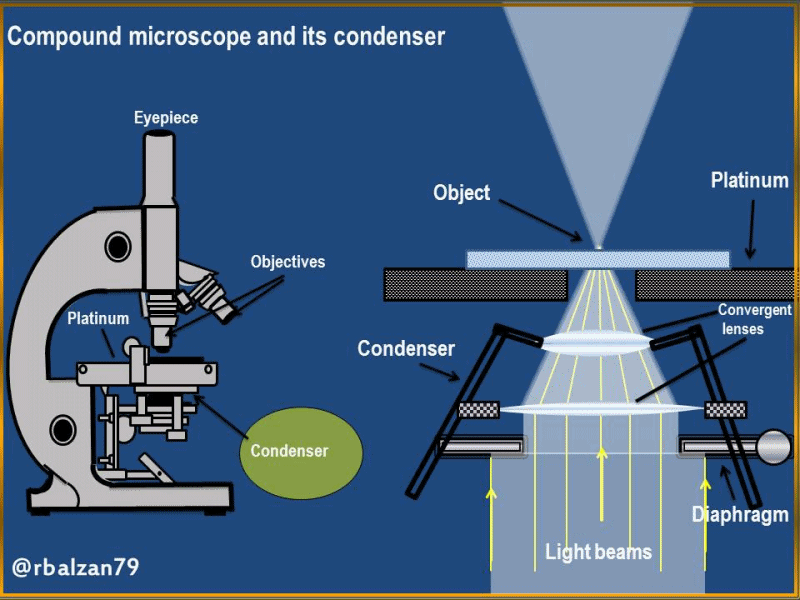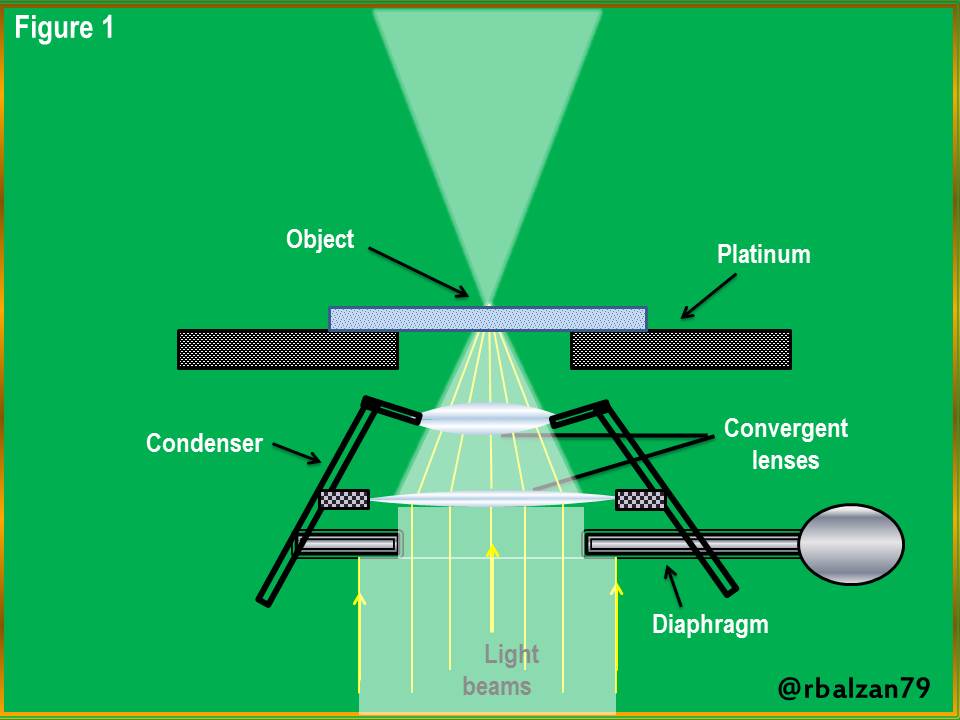Technology in the study of light / Optical system of a compound microscope

Introduction
Many have been the optical instruments of great impact in innumerable activities of our daily life, where, the microscope represents one of them, and the same one by its great benefit in the study of cells and weaves is possible to locate them in important laboratories of our academies with the purpose of being able to teach Biology, Microbiology, Embryology, among others, and from there its application spreads towards all the field of science.
It is important to remember that this optical instrument has great complexity due to the fact that it is constituted or composed of a series of lenses, both convergent and divergent in different parts of the instrument, thus constituting the optical system of the instrument.
This optical system of the compound microscope is constituted by the condenser, the objectives and the eyepieces, in this opportunity we will analyze in a very general way the condenser and its constituent elements, where, of course we will find some lenses, as we can observe in the following figure 1.
Figure 1. Diagram of light rays passing through the components of a condenser
The condenser represents the part of the microscope that is located under the plate, and as they could visualize its objective is to concentrate and regulate the rays of light that come either from a natural or artificial source directed towards the specimen to be observed as we saw in figure 1 above.
In addition we could notice the presence of two convergent lenses with the purpose of making converge (principle of refraction) these rays of light towards the circular hole located in the center of the plate, another important element to emphasize is the denominated iris diaphragm and like in our natural optical system (eyes) its function is the one of the regulation of the entrance of the amount of light, and thus to be able to concentrate the greater amount of luminous rays towards the specimen that we wished to analyze.
Conclusion
The condenser represents an extraordinary component of the optical system of a compound microscope, where, we could find essential constituent elements such as a pair of convergent lenses and their important effect of light refraction towards the orifice where we placed the sample or specimen to study, in addition to the outstanding task of the iris diaphragm and its essential function in regulating the amount of light inside the condenser.
Extraordinary are the contributions of the essential link between science and technology towards our development or evolution in all senses, and without doubt, optical instruments such as complex microscopes are increasingly higher quality and therefore efficiency in the treatment of light rays, this thanks to the continuous renewal of new materials for the development of any element related to the optical system of these instruments.
Until another opportunity my dear and appreciated readers.
Note: The images are of my authorship, made using the Power Point application, and the animated gifs were made with the Photoscape application.
Recommended Bibliographic Reference


@tipu curate 2
Upvoted 👌 (Mana: 0/88) Liquid rewards.
Greetings friend @cryto.piotr for such valuable support.
I think the diversity of techniques for studying light is fantastic.
Greetings @wiseagent, you are right the ways for the understanding of light are wonderful.
There is no doubt that thanks to optical instruments, great contributions have been made to science, as in the case of microscopes, which lately are so powerful that they allow us to observe details smaller than a micrometer, but since their first versions allowed the study of cells, there is no doubt that this allowed the development of sciences such as biology. Thank you for continuing to spread the workings of the technologies that have given us great contributions friend @rbalzan79.
Greetings friend @emiliomoron, you are right the optical instruments have been fundamental for the extension of the knowledge in all the field of the science, thanks for so valuable contrubution. Successes.
Hello friend, the truth is that this is an invention that all of us in the health area applaud, thanks to it we have been able to visualize and detect many pathologies, at the time it was a great advance!
Greetings friend @franyeligonzales, you are absolutely right these optical instruments gave steps to the study of various pathologies, thanks for such a valuable contribution. Successes.
This part of the technology has helped the medical sector a lot by providing a way to be able to see microscopic organisms. Greetings and thank you for sharing.
Greetings friend @carlos84, you are absolutely right these optical instruments have helped a lot to important areas of human knowledge among which is medicine, thanks for such a valuable contribution. Successes.